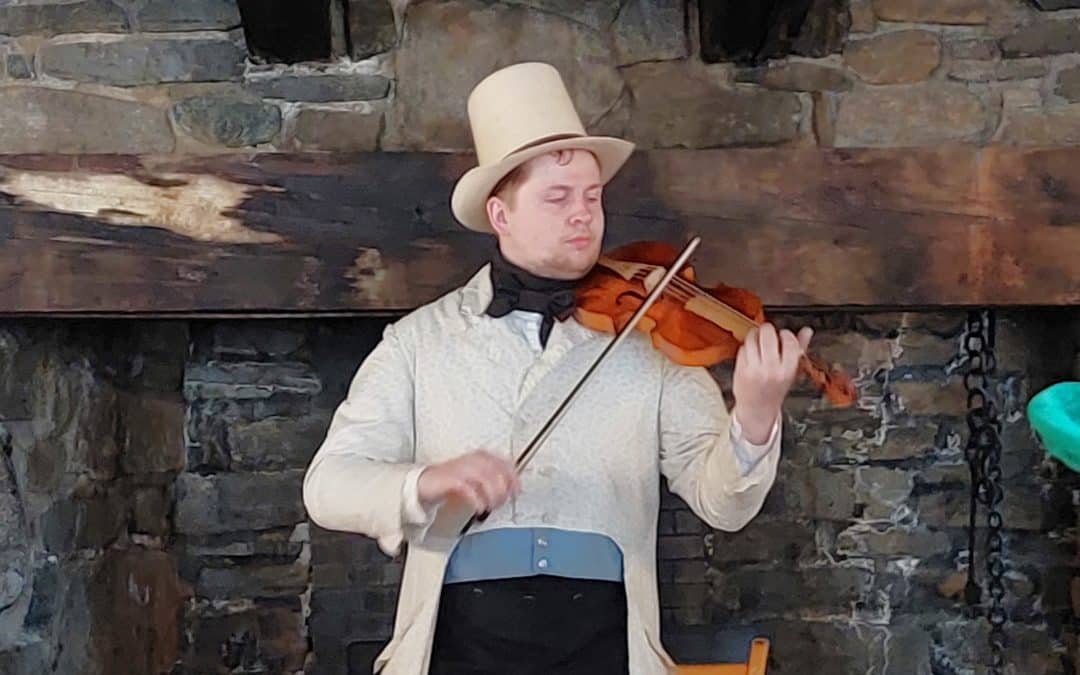Arts and Entertainment Tom Vaughn plays the fiddle while talking about the history of Celtic musicians in the Victorian era.
Reminder Publishing photo by Sarah Heinonen
STURBRIDGE — In honor of St. Patrick’s Day, Old Sturbridge Village hosted a celebration of Celtic culture and history from the early 19th-century.
Old Sturbridge Village is a living history museum that allows visitors to see life as it was in the early to mid 1800s. Historical interpreters in period dress educate visitors while demonstrating the daily tasks of life during that era. While some of the buildings in the village are reproductions of colonial-era structures, most are authentic, dating to the early 19th century, and were moved to the site from around New England.
Coordinator of Music, Arts and Entertainment Tom Vaughn credited performer and educator Katie Hill with organizing the event.
Much of the event focused on the musical traditions of Celtic people. Vaughn presented a demonstration of early 19th-century music written for the fiddle and rocking melodeon, a keyboard instrument that is played on the lap and utilizes accordion-style bellows. He played compositions by several musicians, including the Scottish fiddlers Niel Gow and his son, Nathaniel Gow, and the poet, Thomas Moore. It was not uncommon for poetry to be later set to music, Vaughn said. He also explained that musicians mainly made money from the sale of sheet music and other “merchandise,” similar to today. Vaughn said John Sinclair, an Englishman who adopted a Scottish accent and musical tradition, was “one of our first Celtic celebrities,” touring the United States in the 1830s. Vaughn explained, “That Scottish music really fits in with what was popular at the time” in America.
Another historical interpreter led a presentation on bagpipes, in their different sizes and styles. While most people think of Ireland as the home of Celtic people, he said there were Celtic communities across the British Isles and throughout eastern Europe, who developed different takes on the traditional musical instrument.
The Lee Irish Dance School, with studios in Charlton and Putnam, Connecticut, performed step dances, a traditional form of Irish dance in which the arms are kept at the performer’s side, with a focus on footwork and leg kicks.
Historical interpreters also spoke about life in Ireland before the Irish Potato Famine, also known as the Great Hunger, when the country’s mainstay potato crops were destroyed by blight between 1845 and 1852.
Also on display were historical artifacts, such as the ledger book from a blacksmith who was born in Limerick, Ireland and settled in Sturbridge after immigrating to the United States.
Far from being the only special program at Old Sturbridge Village, the Celtic Celebration was just one of the events the museum runs that tie into holidays and seasons.
In honor of Women’s History Month, on March 30, Old Sturbridge Village is running a program that explores the role of women in early 19th-century America.
Free with admission to the museum are exhibits and presentations on spring tonics and herbal remedies, the Bixby daughters’ contributions to their household through straw-braiding and sewing shoe uppers, information on women missionaries, and a curator’s talk about female academies and women’s education of the day. There is a performance by the Diva Dance School of Warren to explore how dance has historically been a method of empowering women.
Costumed historians will also discuss female civic societies and their connection to the Abolitionism movement. There are also hands-on workshops that require pre-registration.
Until Sunday, April 28, Old Sturbridge Village will admit up to two children, aged 17 or younger, free when purchasing a standard daytime admission ticket for an adult or senior.
Old Sturbridge Village is at 1 Old Sturbridge Village Rd., Sturbridge and is open Wednesday through Sunday, from 9:30 a.m. to 4 p.m. For more information, visit osv.org.


